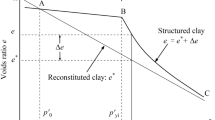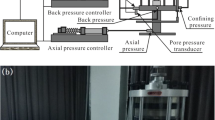Abstract
Conventional triaxial tests are widely used to interpret the stress-strain behavior of soils. The non-uniformity of their stress-strain relationship and the localization of deformation normally occur during shear test and affect the observed test results. This article investigates the non-uniform behavior of artificially structured (i.e., cemented) specimens experiencing shear due to an end restraint under various testing conditions. The conditions investigated include the stress state, the drainage conditions, and the strength improvement associated with the cementation effect. A finite element analysis has been performed using the Modified Structured Cam Clay (MSCC) model, which was developed as a generalized constitutive model for destructured, naturally structured, and artificially structured clays. The shear behavior of artificially structured cylindrical specimens was simulated under both drained and undrained shearing by a coupled hydro-mechanical finite element analysis. The stress-strain distributions and the local stress-strain relations of the artificially structured specimens are compared with those of the destructured specimens. It is evident that the end restraint significantly influences the shear response in drained conditions, particularly for the tests with a high yield stress ratio (YSRiso, which is the ratio of the yield stress to the current stress) and a highly cemented structure. The non-uniform stress-strain behavior is attributed to the non-uniform lateral deformation, which results in a variation in stress paths for different points within the specimen. The different effective stress paths for different points within the specimen affect the overall performance of the specimen, including the yield stresses, the yield strengths and the destructuring processes for a structured specimen. The specimens experiencing shear with high confinement in a Normally Consolidated (NC) state deform relatively uniformly, while those with low confinement in an Over-Consolidated (OC) state display a non-uniform lateral deformation. Hence, the destructured and structured NC specimens exhibit more uniform stress-strain behavior than the OC specimens. The highly structured specimens show more nonuniform stress-strain behavior than the destructured specimens. In conclusion, the end restraint plays significant role in the specimen deformation for both destructured and structured specimens. Special care should be taken for destructured specimens in an overconsolidated state, and for structured specimens in both normally and over-consolidated states.
Similar content being viewed by others
References
ABAQUS (2009). Abaqus 6.9 theory manual, Dassault Systèmes Simulia Corp., RI, USA.
Adachi, T., Oka, F., Hirata, T., Hashimoto, T., Nagaya, J., and Mimura M. (1995). “Stress–strain behavior and yielding characteristics of eastern Osaka clay.” Soils and Foundations, Vol. 35, No. 3, pp. 1–13.
Airey, D. W. (1991). “Finite element analyses of triaxial tests with different end and drainage conditions.” Proceedings of the 7th International Conference on Computer Methods and Advances in Geomechanics, pp. 225–230.
Anagnostopoulos, A. G., Kalteziotis, N., and Tsiambaos, G. K. (1991). “Geotechnical properties of the Carinth Canal marls.” Geotech Geol Eng, Vol. 9, No. 1, pp. 1–26.
Asaoka, A., Nakano, N., and Noda, T. (2000). “Superloading yield surface concept for highly structured soil behaviour.” Soils and Foundations, Vol. 40, No. 2, pp. 99–110.
Baudet, B. and Stallebrass, S. (2004). “A constitutive model for structured clays.” Geotechnique, Vol. 54, No. 4, pp. 269–278, DOI: 10.1680/geot.54.4.269.36354.
Britto, A. M. and Gunn, M. J. (1987). Critical state soil mechanics via finite elements, Halsted Press, New York.
Callisto, L. and Rampello, S. (2004). “An interpretation of structural degradation for three natural clays.” Canadian Geotechnical Journal, Vol. 41, No. 3, pp. 392–407, DOI: 10.1139/T03-09.
Carter, J. P. (1982). “Predictions of the non-homogeneous behaviour of clay in the triaxail test.” Geotechnique, Vol. 32, No. 1, pp. 55–58.
Carter, J. P. and Liu, M. D. (2005). “Review of the structure cam clay model.” Proceedings of Soil Constitutive Models: Evaluation, Selection, and Calibration, ASCE Geotechnical Special Publication 128, pp. 99–132.
Clough, G. W., Sitar, N., Bachus, R. C., and Rad, N. S. (1981). “Cemented sands under static loading.”, Journal of Geotechnical Engineering Division, ASCE, Vol. 107, No. GT6, pp. 799–817.
Cotecchia, F. and Chandler, R. J. (2000). “A general framework for the mechanical behaviour of clays.” Geotechnique, Vol. 50, No. 4, pp. 431–447.
Horpibulsuk, S. (2001). Analysis and assessment of engineering behavior of cement stabilized clays, PhD dissertation, Saga University, Saga, Japan.
Horpibulsuk, S. and Liu, M.D. (2015). “Structured cam clay model with cementation effect.” Geotechnical Engineering Journal of the SEAGS & AGSSEA, Vol. 46, No. 1, pp. 86–94.
Horpibulsuk, S., Miura, N., and Bergado, D. T. (2004). “Undrained shear behavior of cement admixed clay at high water content.” Journal of Geotechnical and Geoenvironmental Engineering, ASCE, Vol. 130, No. 10, pp. 1096–1105, DOI: 10.1061/(ASCE)1090-0241 (2004)130:10(1096).
Horpibulsuk, S., Miura, N., and Nagaraj, T. S. (2005), “Clay-water/cement ratio identity of cement admixed soft clay.” Journal of Geotechnical and Geoenvironmental Engineering, ASCE, Vol. 131, No. 2, pp. 187–192, DOI: 10.1061/(ASCE)1090-0241(2005)131:2(187).
Horpibulsuk, S., Liu, M. D., Liyanapathirana, D. S., and Suebsuk, J. (2010). “Behaviour of cemented clay simulated via the theoretical framework of Structured Cam Clay model.” Computers and Geotechnics, Vol. 37, Nos. 1-2, pp. 1–9, DOI: 10.1016/j.compgeo.2009.06.007.
Kasama, K., Ochiai, H., and Yasufuku, N. (2000). “On the stress-strain behaviour of lightly cemented clay based on an extended critical state concept.” Soils and Foundations, Vol. 40, No. 5, pp. 37–47.
Kavvadas, M. and Amorosi, A. (2000). “A constitutive model for structured soils.” Geotechnique, Vol. 50, No. 3, pp. 263–273.
Khalili, N. and Liu, M. D. (2008). “On generalization of constitutive models from two dimensions to three dimensions.” International Journal for Numerical and Analytical Methods in Geomechanics, Vol. 32, No. 00, pp. 2045–2065, DOI: 10.1002/nag.740.
Lade, P. V. (1982). “Localization effects in triaxial tests on sand.” Proceedings of the International Union of Theoretical and Applied Mechanics. Symposium on Deformation and Failure of Granular Materials, Rotterdam, pp. 461–472.
Lee, K., Chan, D., and Lam, K. (2004). “Constitutive model for cement treated clay in a critical state framework.” Soils and Foundations, Vol. 44, No. 3, pp. 69–77.
Liu, M. D. and Carter, J. P. (1999). “Virgin compression of structured soils.” Geotechnique, Vol. 49, No. 1, pp. 43–57.
Liu, M. D. and Carter, J. P. (2000). “Modeling the destructuring of soils during virgin compression.” Geotechnique, Vol. 50, No. 4, pp. 479–483.
Liu, M. D. and Carter, J. P. (2002). “A structured cam clay model.” Canadian Geotechnical Journal, Vol. 39, No. 6, pp. 1313–1332, DOI: 10.1139/T02-069.
Liu, M. D. and Carter, J. P. (2003). “Volumetric deformation of natural clays.” International Journal of Geomechanics, ASCE, Vol. 3, No. 2, pp. 236–252, DOI: 10.1061/(ASCE)1532-3641(003)3:2(236).
Liyanapathirana, D. S., Carter, J. P., and Airey, D. W. (2005). “Numerical modeling of Nonhomogenous behaviour of structured soils during triaxial tests.” International Journal of Geomechanics, ASCE, Vol. 5, No. 1, pp. 24–34, DOI: 10.1061/(ASCE)1532-3641(2005) 5:1(24).
Potts, D. M. and Gens, A. (1985). “A critical assessment of methods of correcting for drift from the yield surface in elastoplastic finite element analysis.” International Journal for Numerical and Analytical Methods in Geomechanics, Vol. 9, No. 2, pp. 149–159.
Rouainia, M. and Muir Wood, D. (2000). “A kinematic hardening constitutive model for natural clays with loss of structure.” Geotechnique, Vol. 50, No. 2, pp. 153–164.
Sheng, D., Sloan, S. W., and Yu, H. S. (2000). “Aspects of finite element implementation of critical state models.” Computational Mechanics, Vol. 26, No. 2, pp. 185–196.
Sheng, D., Westerberg, B., Mattsson, H., and Axelsson, K. (1997). “Effects of end restraint and strain rate in triaxial tests.” Computers and Geotechnics, Vol. 21, No. 3, pp. 163–182.
Small, J. C., Booker, J. R., and Davies, E. H. (1976). “Elasto-plastic consolidation of soil.” International Journal of Solids and Structures, Vol. 12, No. 32, pp. 431–448.
Suebsuk, J., Horpibulsuk, S., and Liu, M. D. (2010). “Modified structured cam clay: A generalised critical state model for destructured, naturally structured and artificially structured clays.” Computers and Geotechnics, Vol. 37, Nos. 7-8, pp. 956–968, DOI: 10.1016/j.compgeo.2010. 08.002.
Suebsuk, J., Horpibulsuk, S., and Liu, M. D. (2011). “A critical state model for overconsolidated structured clays.” Computers and Geotechnics, Vol. 38, No. 5, pp. 648–658, DOI: 10.1016/j.compgeo. 2011.03.010.
Uddin, K. (1995). Strength and deformation behavior of cement–treated bangkok clay, D. Eng. Thesis, Asian Institute of Technology, Bangkok, Thailand.
Author information
Authors and Affiliations
Corresponding author
Rights and permissions
About this article
Cite this article
Suebsuk, J., Horpibulsuk, S. & Liu, M.D. Finite element analysis of the non-uniform behavior of structured clay under shear. KSCE J Civ Eng 20, 1300–1313 (2016). https://doi.org/10.1007/s12205-015-0009-9
Received:
Accepted:
Published:
Issue Date:
DOI: https://doi.org/10.1007/s12205-015-0009-9




